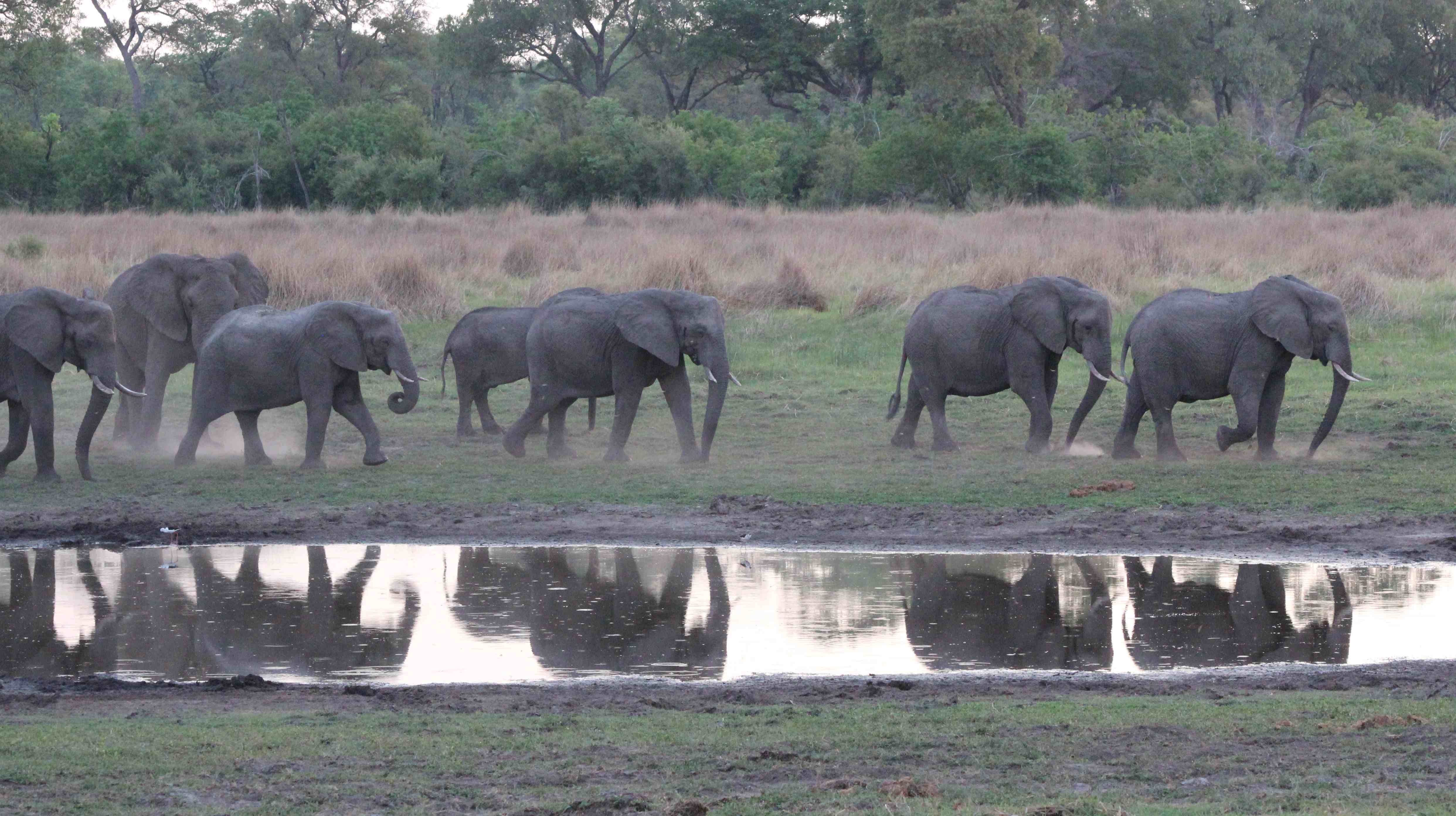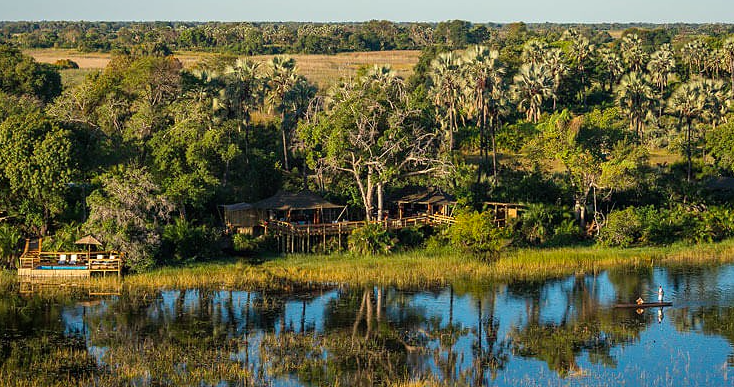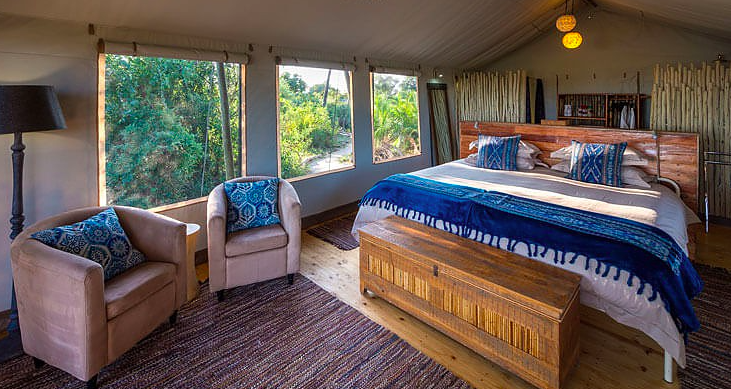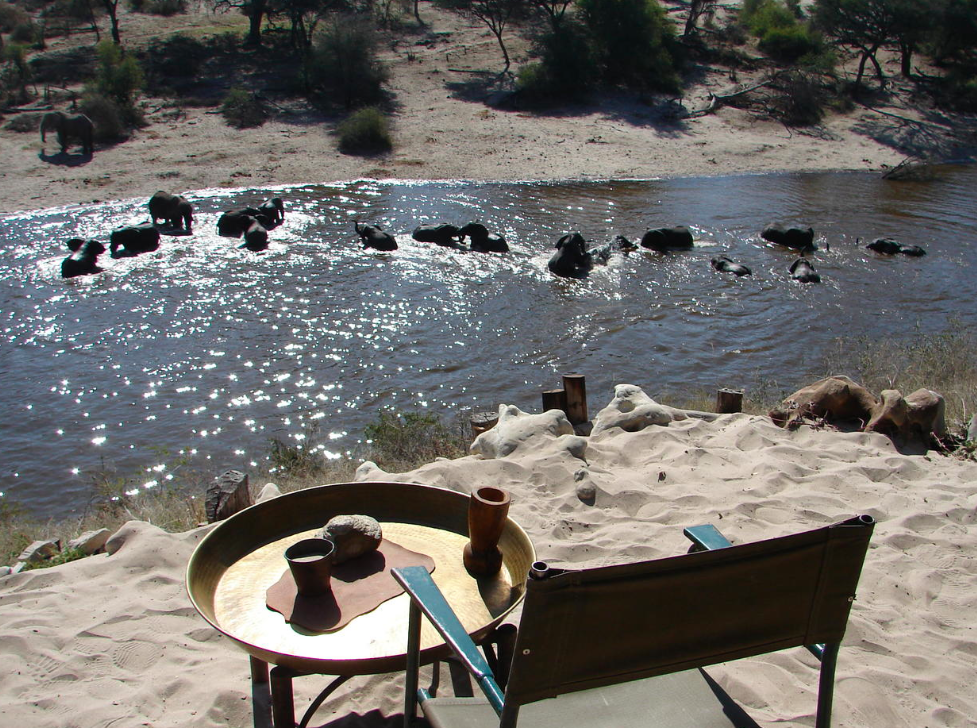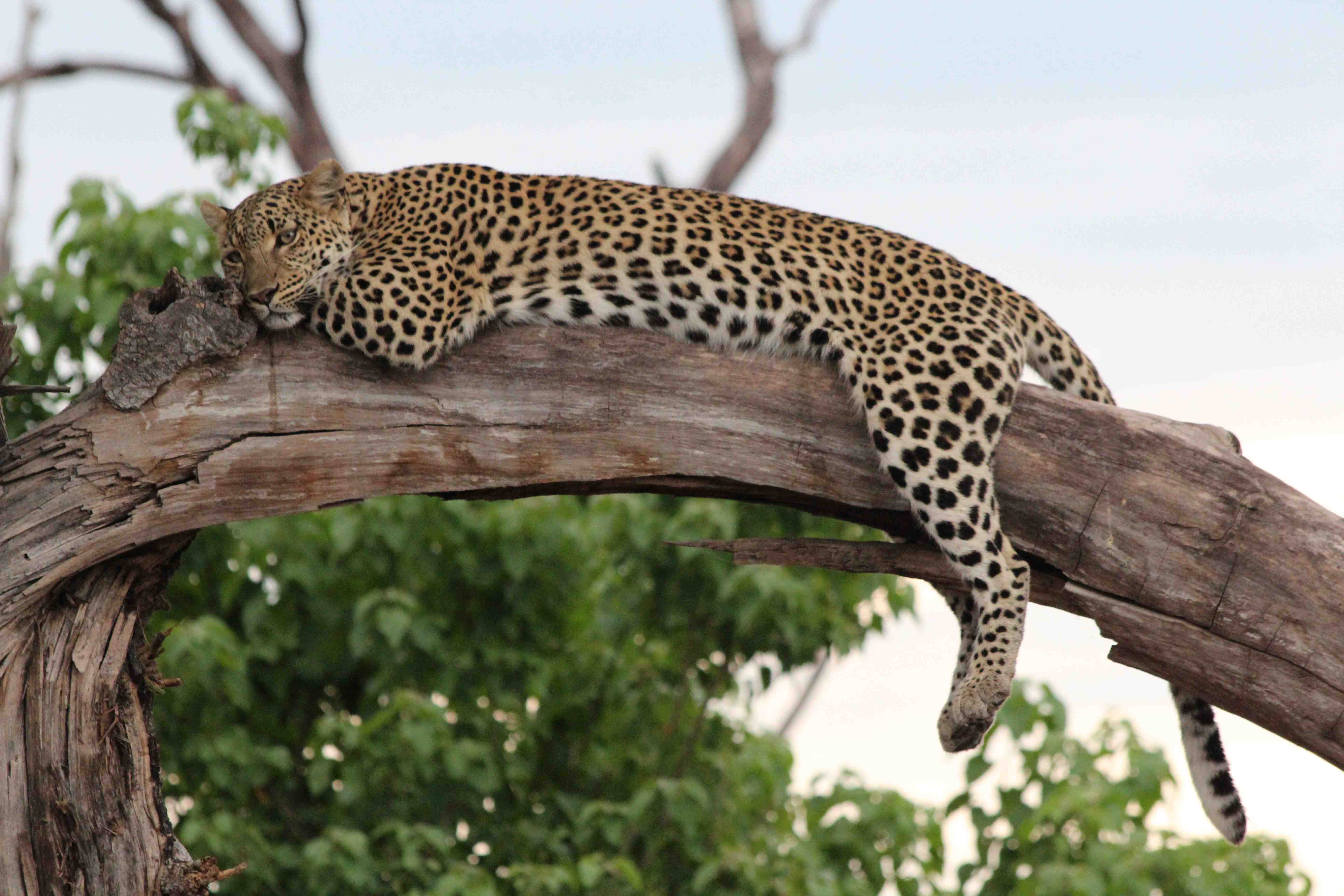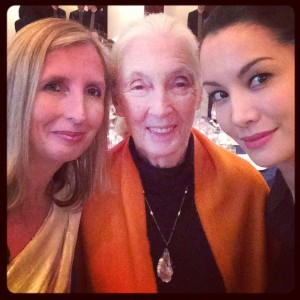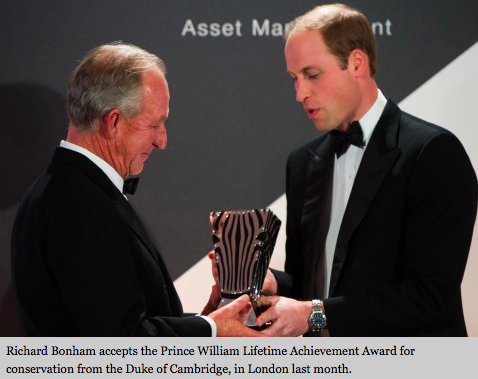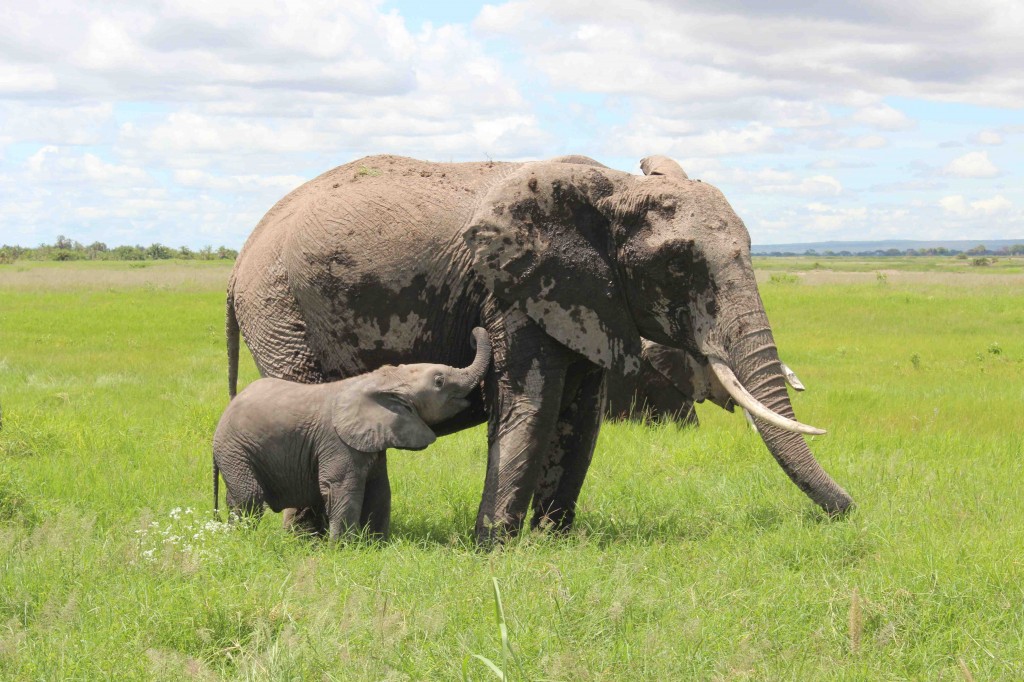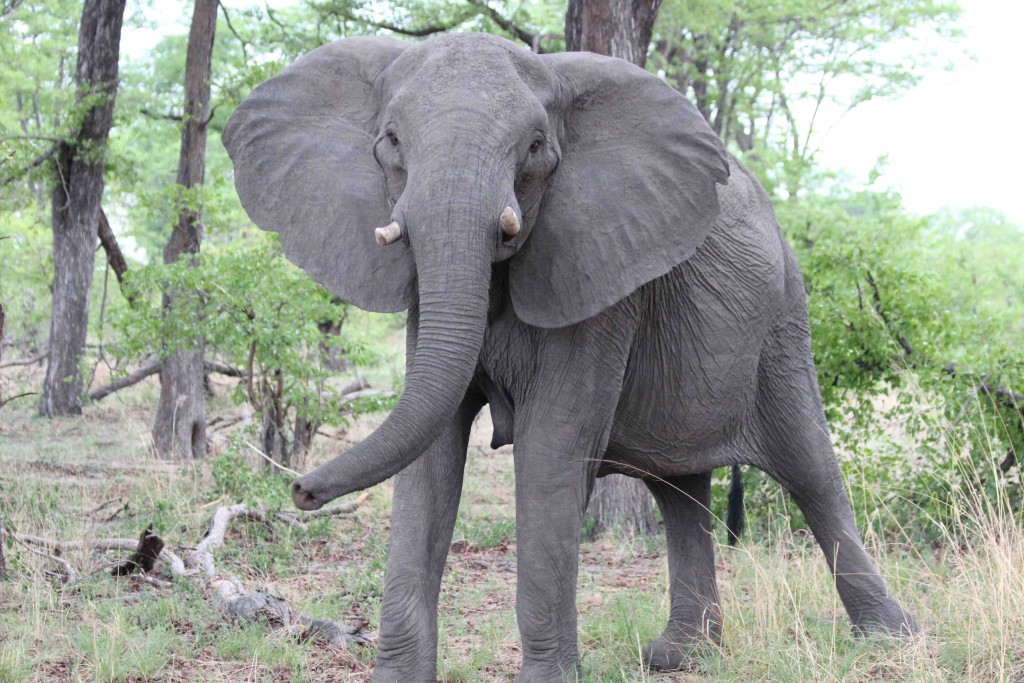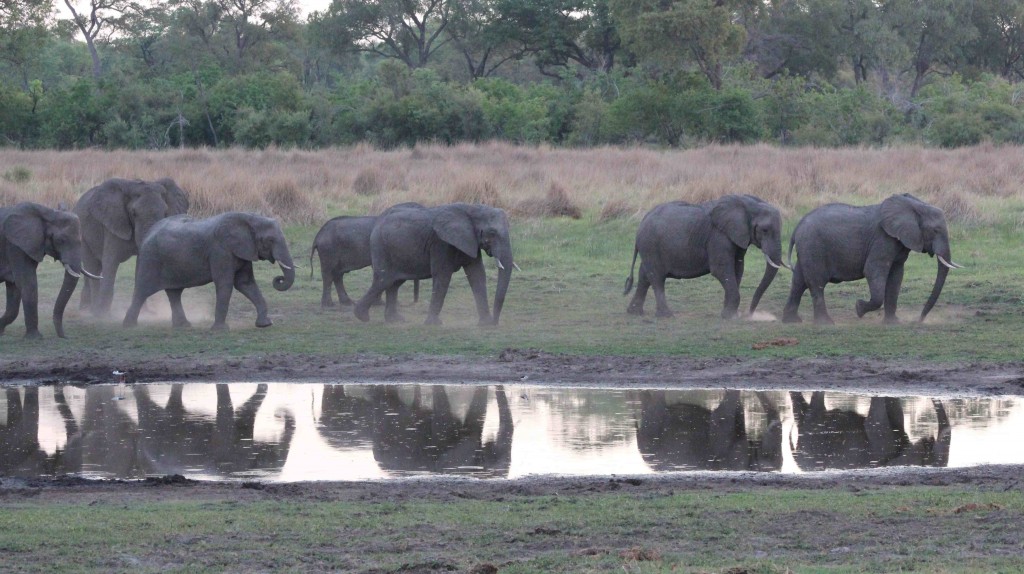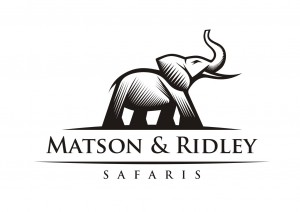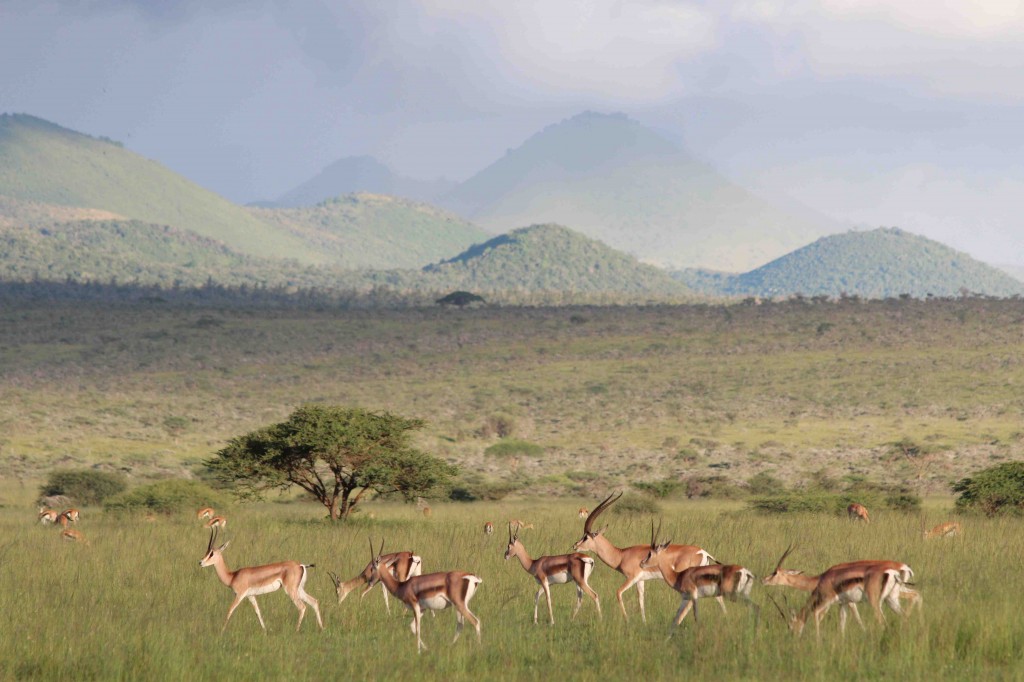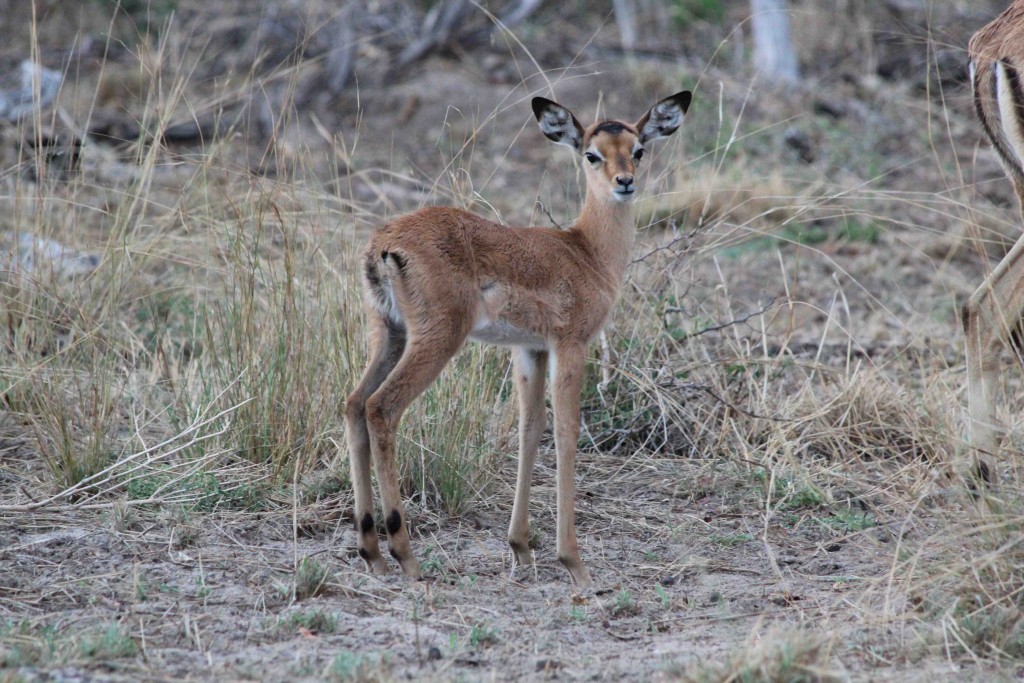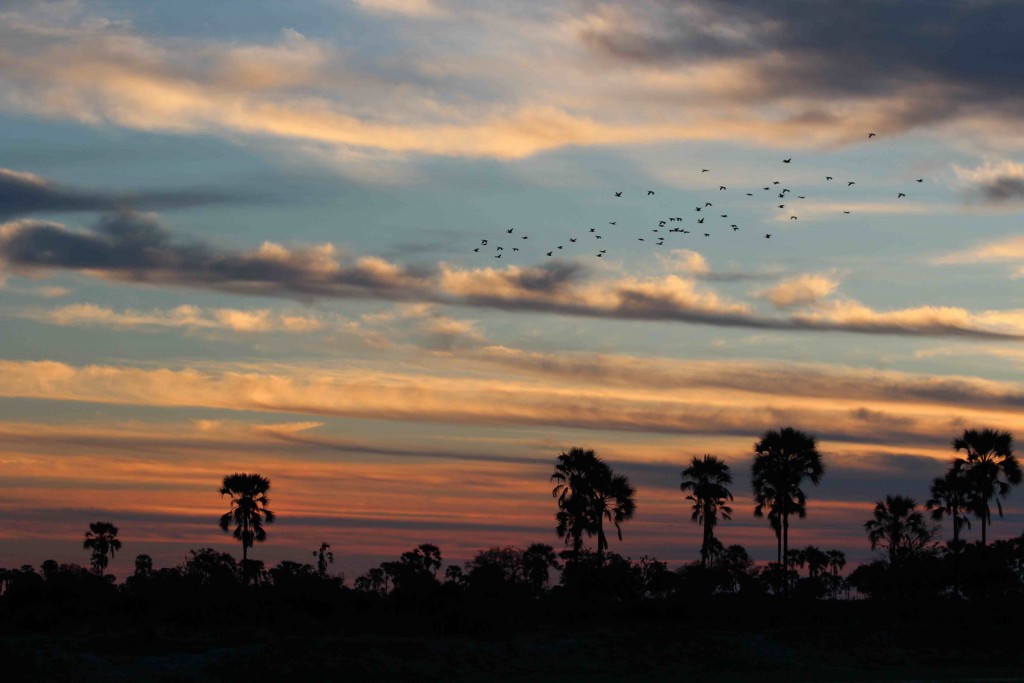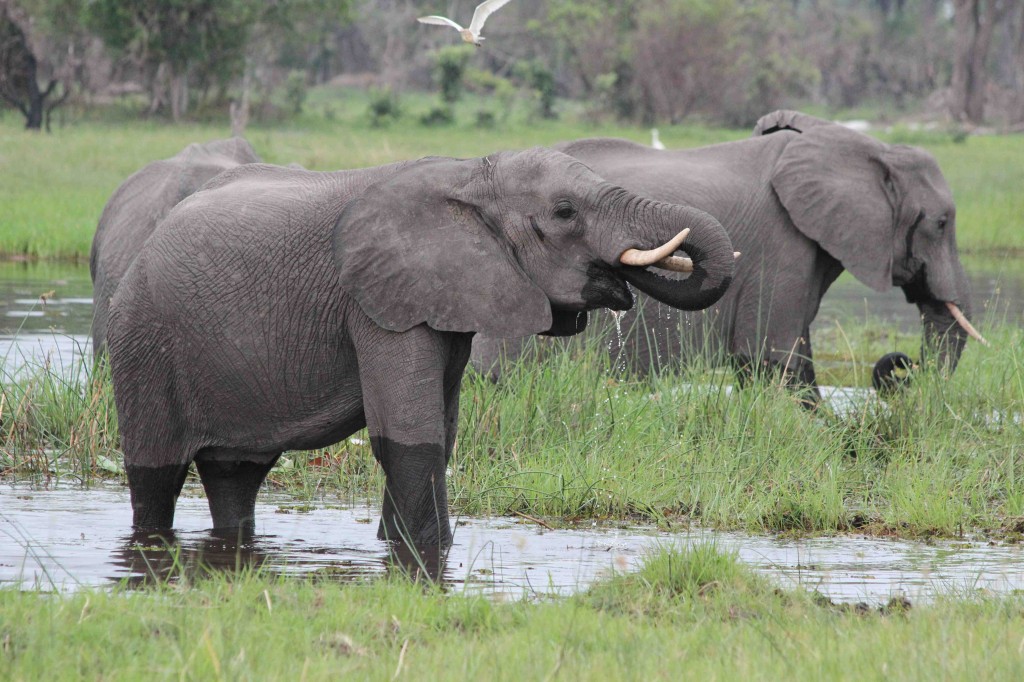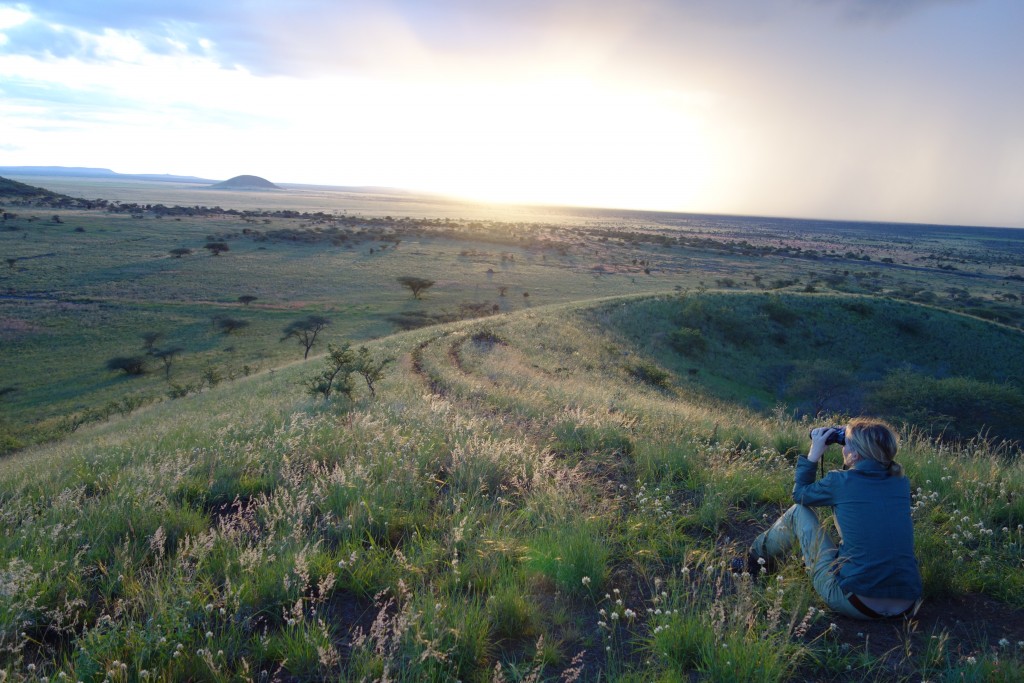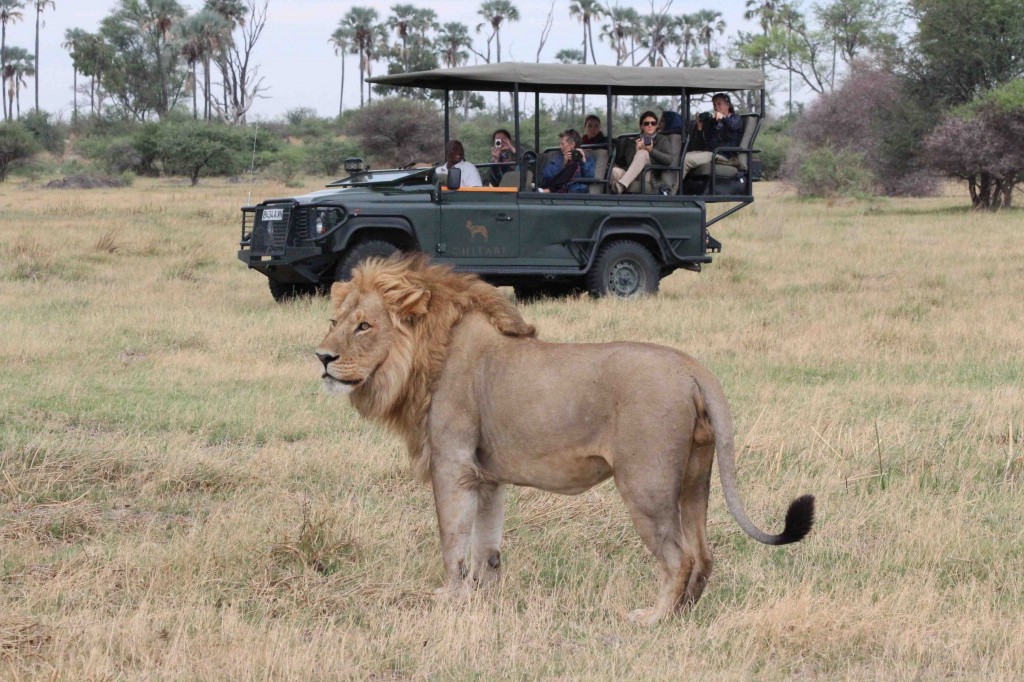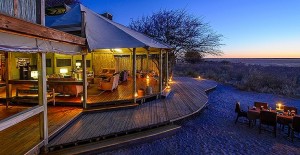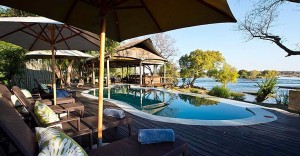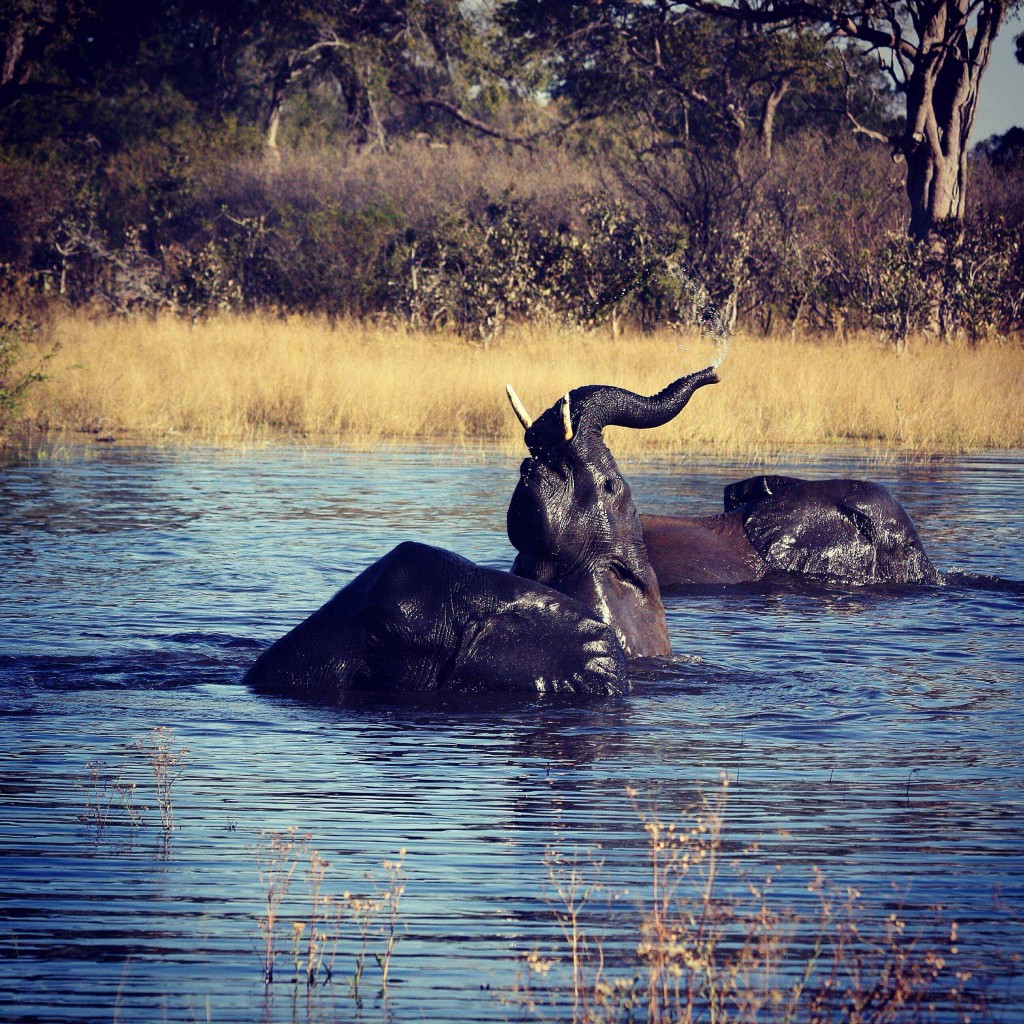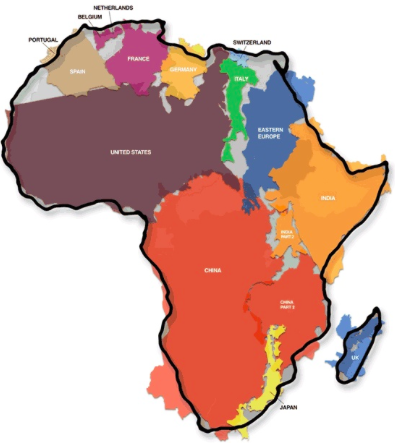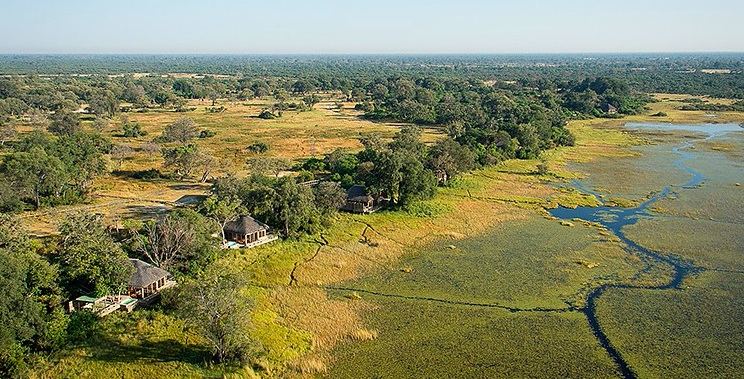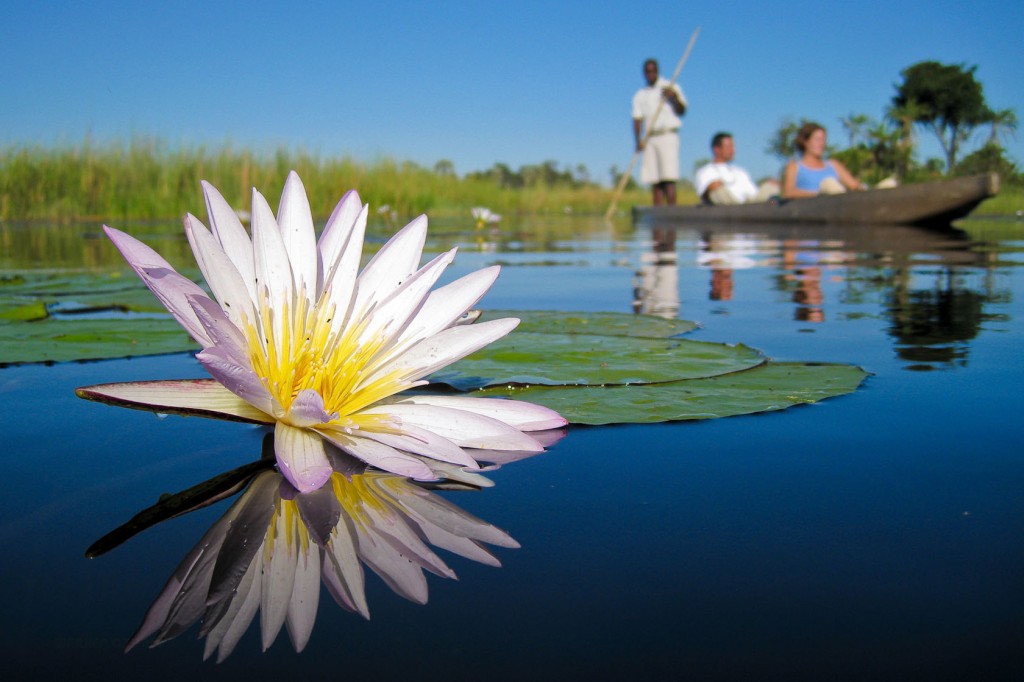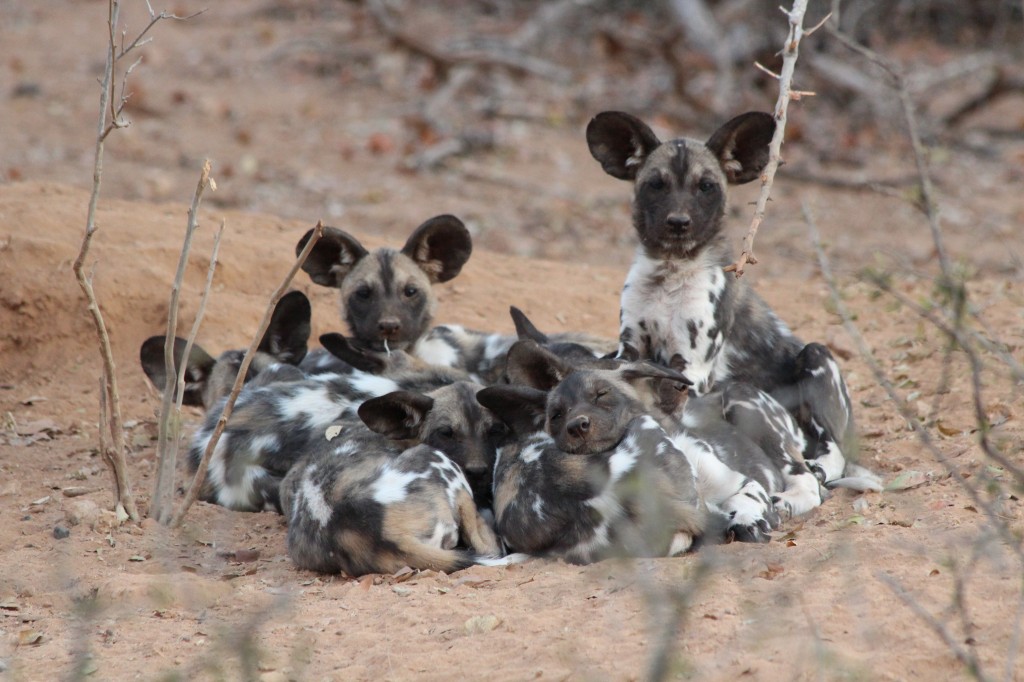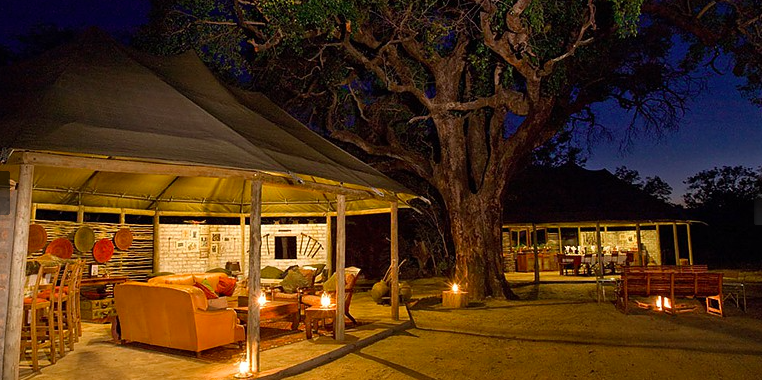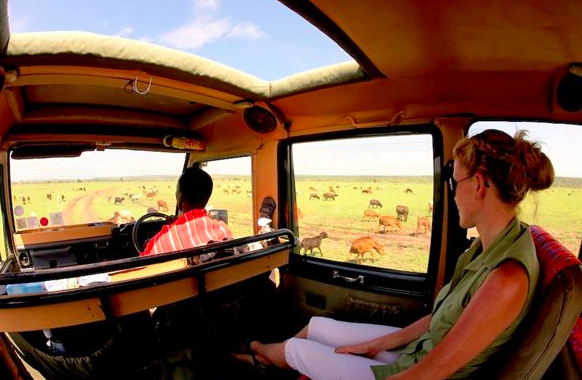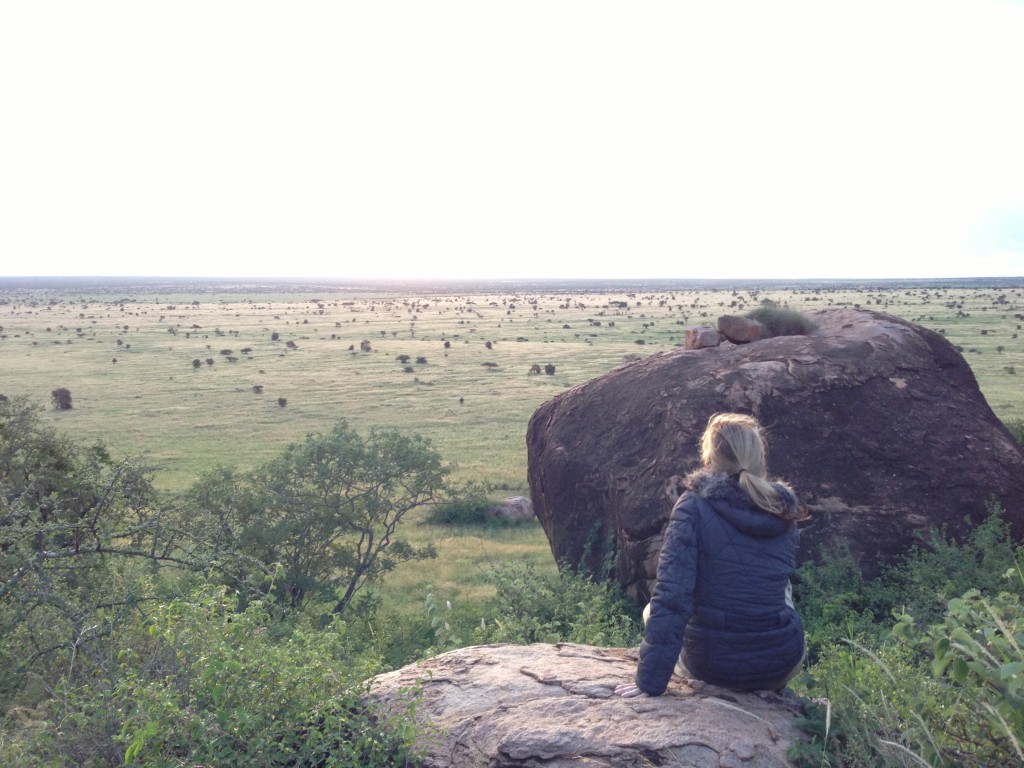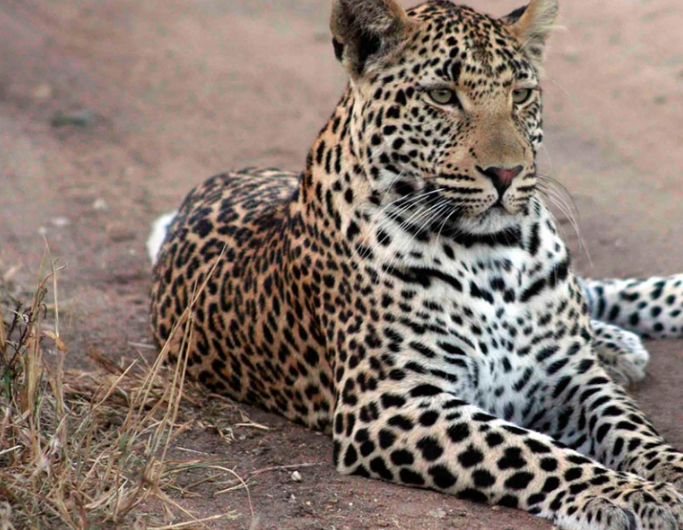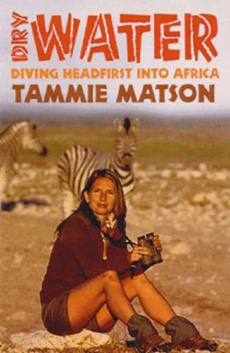Join my Botswana Safari – June 2017
Announcing my Botswana safari for 2017 is now available for you to join! This is an exclusive safari for just 8 people with me, combining the World Heritage wetlands and wildlife fiesta of the Okavango Delta, the elephant-rich woodlands of the Khwai region and the Makgadigadi Pan among the San Bushmen. It’s 7 nights in one of the world’s last great wildernesses and a safari not to be missed if you love animals and Africa at its wildest!

One of the great things about being in Botswana is you can see lions like this big guy at close range and completely unworried about our vehicle.
As with all my safaris, we’ve focused on ethical safari camps that make a difference, but also keeping to the highest standard, especially when it comes to the wildlife experience. On my last Botswana safari, my group were blown away by how much wildlife we saw at close range, including lion after lion after lion, tonnes of elephants (Botswana has the largest elephant population in Africa), spotted hyaena pups at a den, African wild dogs stalking a giraffe, cheetah, baby impalas…. We were there then in the low season (green season) but this time we’re going just after the Okavango floods so we will see the wetlands in all their glory! Take a look at the amazing shots from my 2014 safari to Botswana here. As with all the safaris I personally lead, I’ll be talking through the animal behaviours and conservation issues as we go along, and there are always great conversations by the campfire after a day out in the bush.
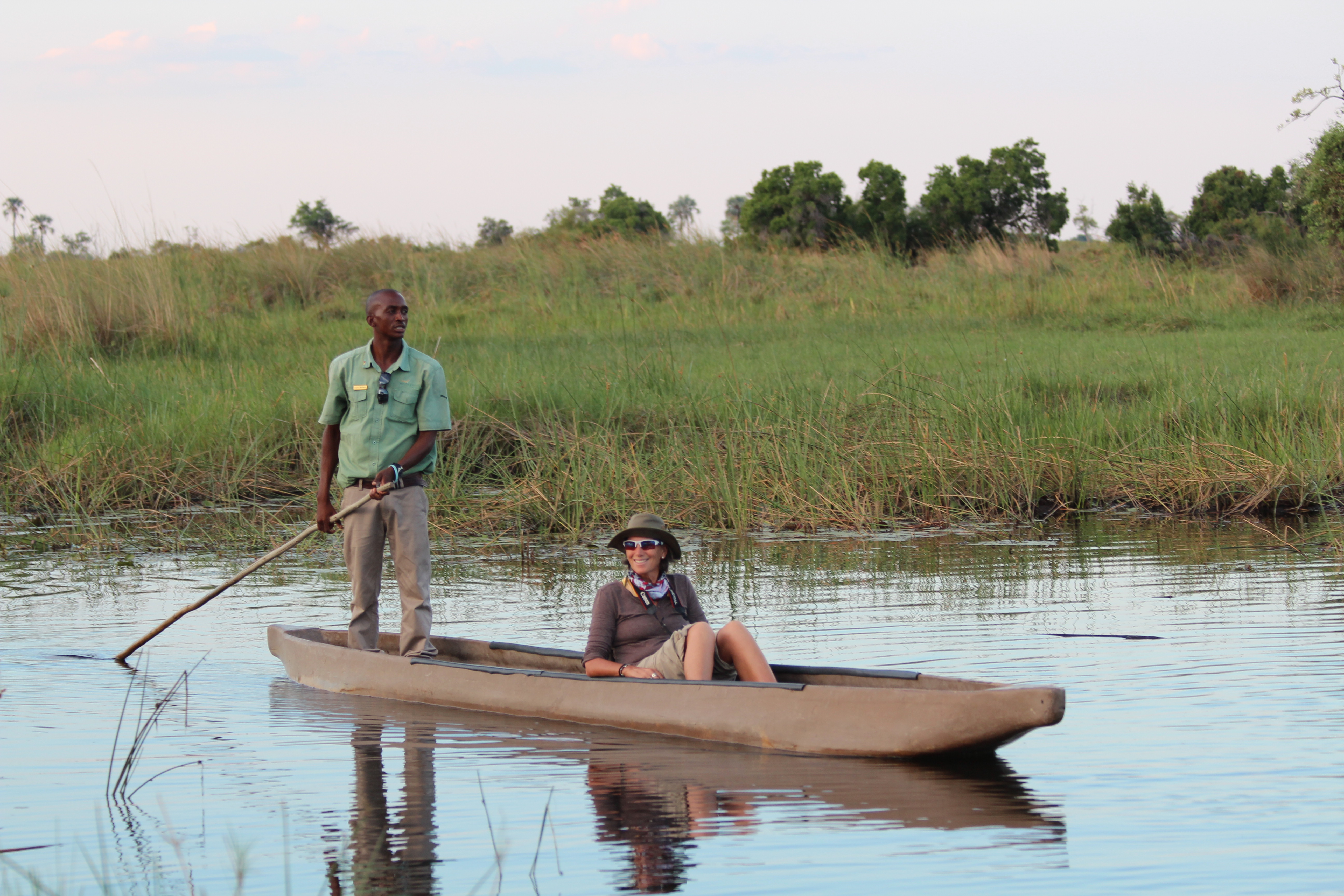
Seeing the Delta from a mokoro is a must-do experience and incredibly peaceful. Last time we were lucky enough to see some sitatunga!
Here’s the itinerary for June 2017:
You will make your way from wherever you are in the world to Maun, Botswana, where the safari starts and ends. International flights are not included in the price, but all internal flights and transfers from the start of the safari in Maun to the end in Maun are included, as are all activities, meals, drinks, conservation and park fees.
June 16: Light aircraft charter to Khwai area, staying at the community-owned Khwai Camp for 2 nights among the elephants in the mopane woodlands. (NB. This camp has just changed hands so the new website is coming soon, but for those in the know it was previously on my itinerary in 2014. For full details of the camp, contact me for the itinerary. Suffice to say it is in awesome part of the Okavango with tonnes of elephants!!)
June 18: Light aircraft charter from Khwai area to Pelo Camp for 2 nights, to experience the wetlands for which the Okavango is famous. Here we will try out a mokoro (wooden dugout canoe) to see the wildlife up close on the water.
June 20: Light aircraft charter from Pelo Camp to Maun, followed by 1 hour road transfer to Meno a Kwena Camp, where we will overnight for 3 nights. Experience traditional life on a walk with the Bushmen, watch the elephants and other wildlife drinking at the river in front of camp (including at a floating hide on the Boteti River!), and see desert-adapted wildlife in the Makgadigadi Pans National Park or the Central Kalahari Game Reserve, both within easy reach of the camp. We can even do a sleep out on bedrolls in the park if you like! Click here for more on Meno a Kwena Camp & activities.
June 23: Return to Maun by 1 hour road transfer for your international flight out.
Only 8 people can come on this safari with me as I am limited by room availability, so please register your interest ASAP!
Price is US$5900/person sharing. The price goes down to US$5750/person if you bring a friend to share your room! Note this includes almost everything other than your international flights. You will need to keep some money aside for souvenirs and tips, but there are no visa entry fees for Botswana. Single supplement for those who want their own room is possible.
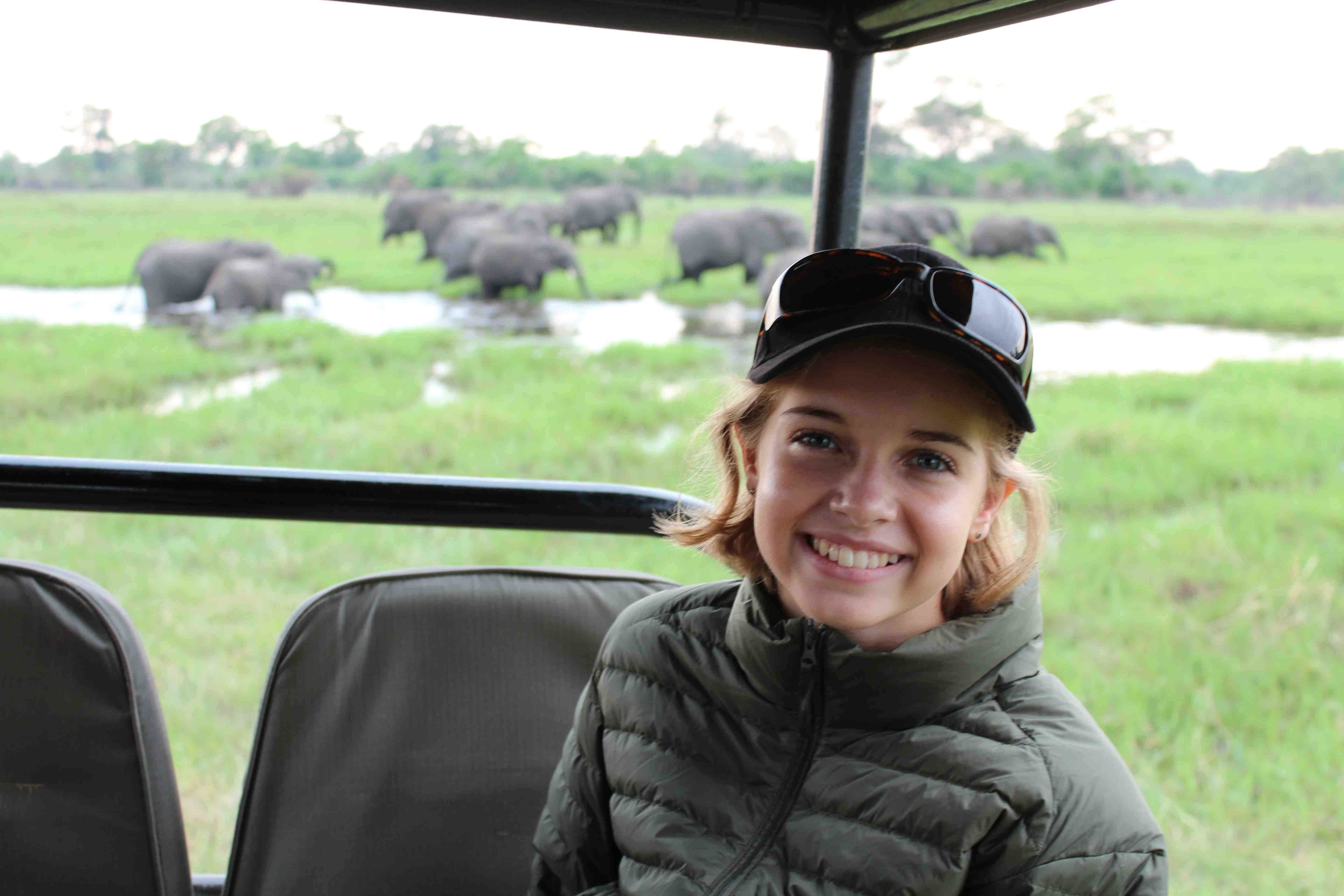
This photo of young Aussie wildlife crusader Alice Bertram was taken at Banoka Camp in 2014 during my group safari, just near where our 2017 safari will be going first….
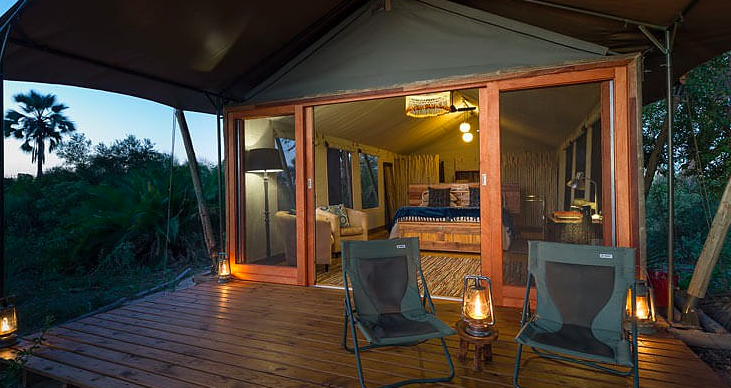
Pelo Camp, inside a guest room – boutique luxury in the bush… I love being behind canvas at night in Botswana as it lets all the wonderful sounds of the animal world in (while keeping the lions out!).
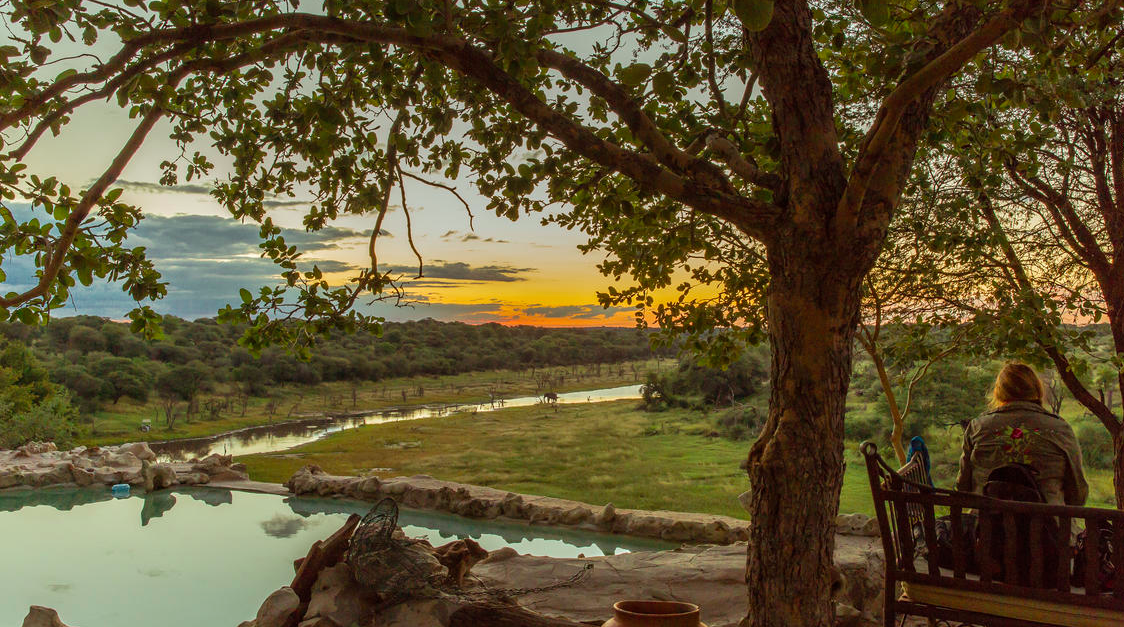
Watch the elephants in the river at sunset while you have your own relaxing time in the pool at Meno a Kwena Camp. Look at that sky!
What more could you want from an African safari? I’d love to have you along with me on this magical journey into the heartland of Africa’s elephants, Botswana, in June 2017. Contact me for the full itinerary now and register your interest!
Price reduction for Kenya & special deals on Botswana!!
Kenya and Botswana are two of the most amazing wildlife destinations in Africa, but they do come at a price. If you’ve always wanted to travel to these countries, you can save a lot of money by going in the green season.
Today I can announce a great saving on my Kenyan safari from 20-27 February next year. I’m taking a small, intimate group of adventurers with me to the world famous Maasai Mara in Kenya, following a visit to the wonderful elephant orphanage run by Dame Daphne Sheldrick in Nairobi, staying in the best areas in communal conservancies that directly benefit local Maasai communities. I still have a few spots left and I’m offering them at a reduced rate if you get in quick!
Price now reduced to US$5000/per person sharing!! Contact me now for the full itinerary. This saving is only valid for the next two weeks til 6th November, so get in quick for this special last minute rate!
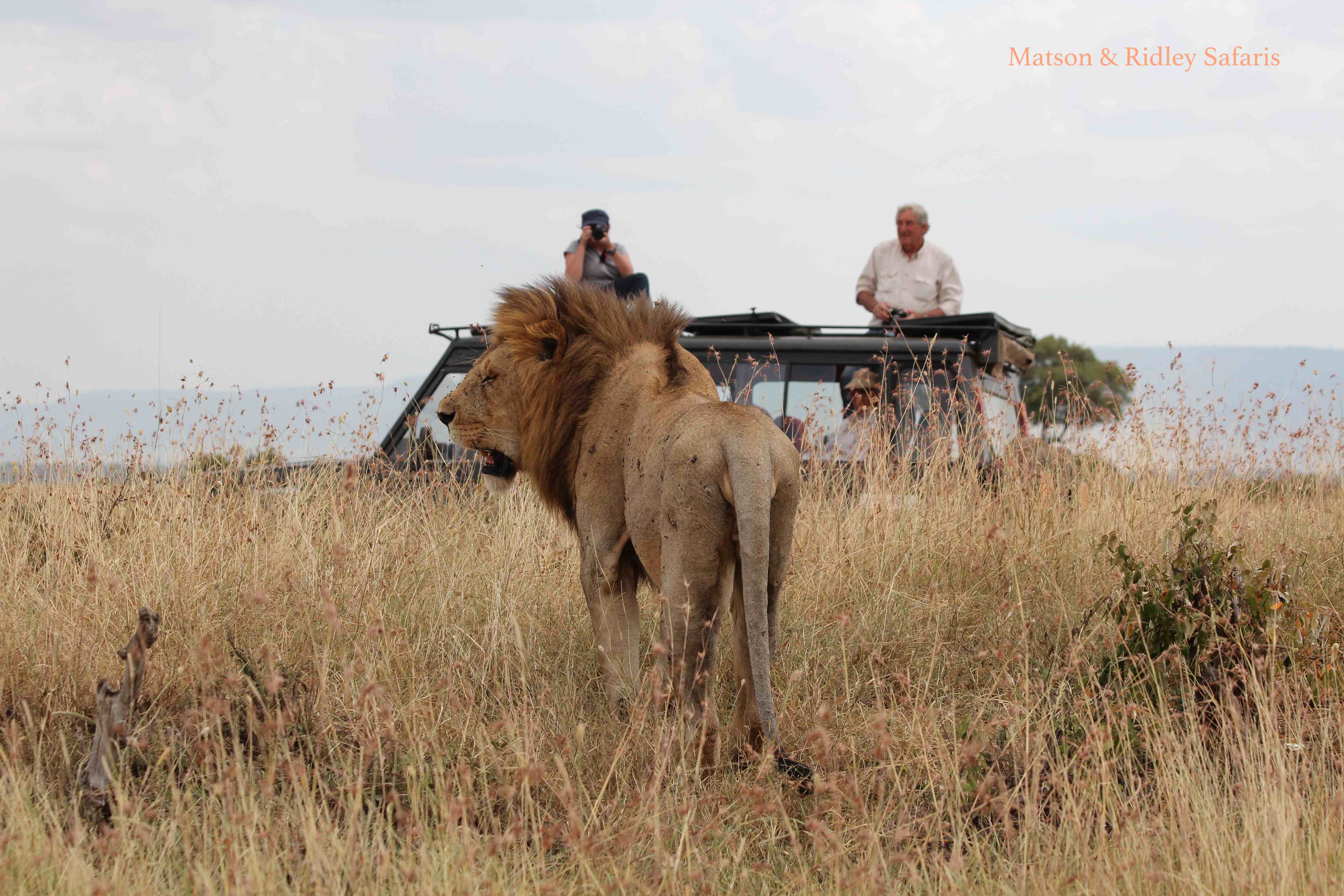
Our group watches an exhausted male lion (in between a week of mating every twenty minutes) – photo taken on my group safari July 2015
Check out my photos from the Maasai Mara in July here – it’s spectacular! Our trip in February is during the green season which is just beautiful and full of baby animals….
And there are some great deals going in the Okavango Delta if you can travel between January and April next year. Consider going on a 6 night safari at prime Wilderness Safaris explorations camps in this world heritage area for just US$3,499/person sharing (valid for travel between Jan-April, set dates). This is a great saving in one of the most wildlife-rich parts of Africa, and much less expensive than going in peak season. But availability won’t last so get in touch quickly if you’re interested.
For information on special deals in Botswana or to sign up for my Kenyan safari in February at the reduced rate, get in touch with me now!
Elephant Round Up
We’ve seen some promising signs from China in the last week in relation to the ivory trade driving elephant poaching in Africa, with the Chinese government conducting their third ivory destruction in the last eighteen months and committing to phase out its legal, domestic ivory industry. No time line has yet been given, but it is encouraging to see the Chinese taking stronger measures and the steps have been lauded by conservation organisations.
So are attitudes changing? A survey by WildAid showed that 95% of Chinese supported a total ban on ivory sales. Another one by WildAid, the African Wildlife Foundation and Save The Elephants showed that three quarters of Hong Kong residents supported a ban on ivory sales there too. Hong Kong is a major transit point for ivory to Chinese market places.
The Let Elephants Be Elephants team participated in an awareness and fund raiser for elephants in Hong Kong in November last year, run by the Hong Kong Elephant Society. Our campaign has always been focused on South East Asia, but we are now starting to form some good working partnerships with organisations in Hong Kong as well.
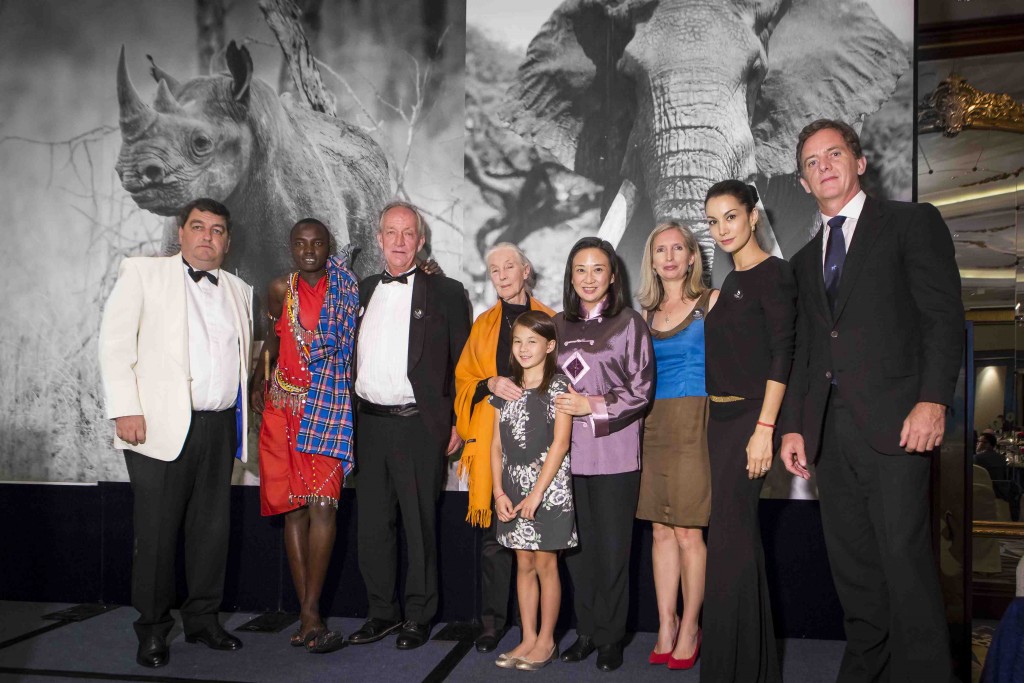
HK Elephant Society co-founder Colin Dawson, Maasai spokesperson John Tabula, Big Life’s Richard Bonham, Jane Goodall, one of the amazing kids who started the movement which led to HK’s first ivory crushing, pro-environment legislator Elizabeth Quat, the LEBE team (me and Nadya Hutagalung), HK Elephant Society co-founder Ted Hodgkinson.
Other organisations that participated on the night were the Big Life Foundation, David Sheldrick Wildlife Foundation and the Jane Goodall Foundation.
There were some great heroes of conservation in the room that night. In one of the most special moments of my career, I had the pleasure of meeting Dr Goodall (photo above), whose book “In The Shadow of Man” I read when I was dreaming of becoming a wildlife researcher back in the early 1990s. Richard Bonham, COO of Big Life, went on from our event in Hong Kong to London to accept Prince William’s Life Time Achievement Award for conservation, so we were in fine company! Also there in support of elephants were the pro-environment Hong Kong politician, Elizabeth Quat and Hong Kong For Elephants‘ campaigner Alex Hofford. The night raised significant funds for three organisations, including a donation to LEBE’s Thailand demand reduction campaign.
Following successful launches in Singapore, Hong Kong, the Philippines and Indonesia, the Let Elephants Be Elephants campaign is planning to focus on Thailand’s ivory market in the next phase of the campaign, and this year so far we’ve been working on bringing in funds and developing the partnerships to roll out the campaign.
We’re heartened by the fact that the Thai government has taken some strong measures towards controlling their ivory markets in the last year, including strengthening laws around ivory trade and clamping down on registration of ivory across the country. We don’t entirely know what this means yet for ivory markets and elephants. LEBE co-founder Nadya Hutagalung found fewer stalls selling ivory in Bangkok during her visit there earlier this year than last year during the filming of the LEBE documentary, which was encouraging, but may also suggest the sellers are uncertain of what the future holds. What we don’t know is whether ivory sales have simply gone underground, and how long existing measures will be enforced. The need for education to reduce demand for ivory remains as strong as ever.
So what’s happening in Africa? Well, the bad news this week has been the WCS report showing the devastating loss of half of Mozambique’s elephants in the last five years. In neighbouring Tanzania, new census figures have shown a decline of 60% of the nation’s elephants in the last five years. This is happening right now! In addition, in western and central Africa, the ivory war is as bloody as ever.
Thankfully there was some good news in amongst the bad this week in the elephant world. This week I was heartened to see a report by WCS from Uganda showing that their elephant population is on the rise, with more than 5000 across the country (still quite low numbers in the big scheme of things however). And don’t forget that in countries like Botswana, the country with the world’s largest elephant population, they are doing just fine. I saw a commentary just today suggesting that South Africa has ‘too many’ elephants, a term I used to hear a lot when I lived in southern Africa in the early 2000s, but not so much these days. Does South Africa have too many elephants or just too little land?
With some countries at threat of losing most or even all of their elephants in the next decade, and others with good, strong populations, we need to look at Africa’s elephant population as just that – Africa’s – rather than one or another country’s elephants, because the species roams across human-defined border as if they don’t exist. The good thing about this is that elephants can expand into new areas when they know they are safe, repopulating former ranges across borders, and that’s where the idea of Africa as a series of interconnected parks and communal conservancies gets interesting. This is already happening in several countries, with great results.
I guess my point this week is that it’s easy to get overwhelmed by all the stories out there about the ivory wars, but bear in mind that both Africa and Asia are big places and the situation is different everywhere. While we might be losing the ivory war in some countries, and we may well see localised extinctions of elephants in some parks and/or countries in the next decade, we’re starting to see improvements in others. So don’t lose hope.
Remember that if you love Africa and you love elephants, make your next safari an ethical one that ‘gives back’ to the local communities who live with elephants and ensure their survival. Drop me a line for more info on joining one of my conservation focused safaris that make a difference.
Africa in the Green Season – Two Special Deals!
One of the most common questions I get asked about Africa is “When is the best time to go?” The answer to this isn’t as simple as you might think, and anyone who’s experienced the complexity of Africa’s seasons will tell you exactly that.
Of course, there is a typical ‘safari season’ between June and October, which is when most people go, during the cooler dry months when there is limited rainfall, moderate temperatures, grasses are low, many shrubs (like the mopanes in southern Africa) drop their leaves, and consequently visibility for wildlife sightings is better. In East Africa, the safari season is when you’ve got the best chance of seeing the famous Great Wildebeest Migration. The disadvantage of going in the ‘prime time’ for safaris, between about June and October, is that you pay a premium for the experience, in some places almost twice the price of other times of year.
So when do the locals go on safari? Well, here’s the big secret. It’s often not peak season, but in the ‘green’ season, between about November and May. Personally it’s my favourite time of year and here’s why I reckon it’s worth considering.
1) Baby animal fiesta
When the rains finally come in Africa, nature responds with fresh green grass and this triggers a baby boom that will melt the heart of even the most hardened game ranger. Baby impalas, baby cheetahs, baby springboks, baby wildebeests, baby zebras…. It’s a very special time of year around Feb/Mar when many of the babies drop and I just love being there then to witness it.
2) Epic thunder storms
To me Africa’s always been a place where I feel truly alive. It’s hard to explain if you haven’t been there. But during a thunderstorm the energy of the place is even more amazing. There’s nothing like the smell of fresh rain on earth that hasn’t seen water in six months or so. The photography opportunities afforded by the striking cloud formations as a big storm comes in are a dream for photographers. Sure, you might get bogged in the mud the next day, but hey that’s part of the fun!
3) Won’t hurt your wallet as much
Another major advantage of travelling in the green season is that prices are much lower because it’s not peak season. Sometimes you can pay more than half the price of peak season in the most popular safari countries like Kenya and Botswana. So your money stretches further, which means you can stay in Africa longer!
My Green Season Safaris in 2016
I am leading two ethical safaris in 2016, the first to Kenya’s Maasai Mara in Feb/Mar and the second to Botswana’s Okavango Delta & Makgadigadi Pan in Oct/Nov, both limited to 10/12 people plus me (yep, you have your own personal zoologist all the way through and I will tell you everything you ever wanted to know about the mating behaviour of dung beetles and the like!). If you’d like to join one of these groups, let me know or contact me for more information.
Kenyan Maasai Mara Safari – Feb/Mar 2016
Day 1: Visit to Daphne Sheldrick’s elephant orphanage & overnight at Ole Serene Lodge, a luxury hotel in a game park in Nairobi
Days 2-4: 3 nights at Naibosho Camp, Maasai Mara, a unique community partnership in an astounding area for wildlife
Days 5-7: 3 nights at the Mara Houses, Maasai Mara, like living in your very own bush house in the wilderness
US$5250/person sharing – limited to 12 people (if we get more than 8 people I can reduce the price of this one further).
All inclusive price (all accommodation, meals, drinks etc), but excludes international flights.
This is exactly the same as my sold-out safari to Kenya this July (peak season), but with an extra night and for a lower price!
Botswana Okavango and Makgadigadi Safari – Oct/Nov 2016
Days 1-3: Arrive in Maun and fly to Pelo Camp, an eco-friendly oasis on a wildlife-rich island in the heart of the world heritage listed Okavango Delta. Activities include wildlife viewing by both mokoro (wooden dugout canoe) and open vehicle.
Days 4-7: Return flight to Maun & drive to Meno A Kwena Camp, home to the San Bushmen & overlooking the Boteti River. Includes cultural activities with the San Bushmen, the chance to see wild meerkats & a full day excursion & sleep-out at the Makgadigadi Pans National Park.
US$5,500/person sharing. Limited to 10 people plus me.
All inclusive price (all accommodation, meals, drinks etc), but excludes international flights.
Dates will be confirmed as numbers firm up, but I need to book these camps now before they sell out so drop me a line now if you’re interested!
Join Author Sally Henderson in Botswana
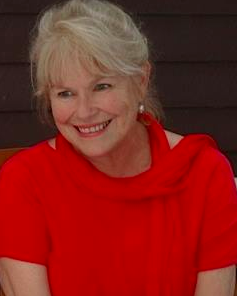 Author Sally Henderson and I have been good friends since long before either of us ever knew we would be published authors. Like me, Sally loves Africa with a passion, and so I’m very excited to offer you the exclusive opportunity to travel to Africa with Sally during Botswana’s amazing green season this year!
Author Sally Henderson and I have been good friends since long before either of us ever knew we would be published authors. Like me, Sally loves Africa with a passion, and so I’m very excited to offer you the exclusive opportunity to travel to Africa with Sally during Botswana’s amazing green season this year!
Sally’s love affair with Africa and its elephants came to life in “Silent Footsteps” and in its sequel, “Ivory Moon”. Join this thoughtfully planned safari and you will experience that passion for yourself as Sally shares her unique perspective of the wilderness and its creatures. You might even learn a thing or two about writing along the way.
A one-off journey that makes a difference to local wildlife and people, the safari incudes the Kalahari Desert, the World Heritage listed Okavango Delta, the Chobe river ecosystem and the majestic Victoria Falls, a truly unforgettable exploration into untamed Africa among an intimate group of like-minded travellers. Traveling in the safety and comfort afforded by one of Africa’s top ecotourism operators, Wilderness Safaris, in partnership with Matson & Ridley Safaris, you will be taken care of every step of the way and can trust that a significant portion of what you pay to go on this safari benefits local people and wildlife.
In the green season you can expect awe-inspiring thunderstorms and sunsets, lots of baby animals and warm summer days and without the crowds and price tag of the dry winter months (check out my recent photos taken in Botswana’s green season last year – click here). Don’t miss this exciting opportunity to join Sally Henderson’s intimate adventure into the Okavango Delta for 9 nights in November this year. This intimate safari is limited to 8 people sharing so contact me now to sign up.
Sunday 29th November – Kalahari Plains Camp
Set in a remote part of the diverse and productive Central Kalahari Game Reserve, this camp offers some of the best summer wildlife viewing opportunities in Africa. Located in the largest conservation area in Botswana, its star attractions include the legendary Kalahari black-maned lion and excellent cheetah viewing. The camp itself overlooks an immense pan with endless horizons and beautiful skies. The main area has a lounge and dining area with a swimming pool and deck. Solar power provides all the electricity and hot water in camp and insulated canvas walls and roof keep temperatures inside the units comfortable. One of the unique experiences at this camp is the interpretive ‘Bushman walk’ where you can immerse yourself in the culture of the Kalahari San.
Tuesday 1st Dec 2015 – Gomoti Tented Camp, Botswana
Gomoti Tented Camp lies in the centre of the private 6 000-hectare Santawani Concession, in the south-east corner of the Okavango Delta. The camp is nestled under large acacia trees in a diverse game-rich area. Most of the concession area comprises a mixed woodland habitat that gives way to open grasslands which can transform into floodplains in years of plentiful water. The area is rich with the wildlife for which the Okavango Delta is famous, including elephants, lions, African wild dogs, cheetahs and leopards.
Friday 4 Dec 2015 – Linyanti Discoverer Camp, Botswana
Set in the 125 000-hectare Linyanti Concession bordering Chobe National Park, Linyanti Discoverer Camp is your base from which to explore this enormous wildlife-rich area. Unrivalled in its remoteness and space, the concession is bisected by an ancient watercourse – the now-flowing Savute Channel. Wildlife is abundant and includes the seldom-seen sitatunga that can be spotted in the waterways, as well as the rare sable antelope.
Mon 7 Dec 2015 –Toka Leya Camp, Zambia
Overlooking the mighty Zambezi River and some of its islands, Toka Leya Camp is siutated in the Mosi-oa-Tunya National Park. The camp’s dining, lounge and bar areas offer ample space for relaxation and are complemented by an infinity pool, with meals served on the sundeck, the pool deck and dining room all overlooking the Zambezi. Situated just 12 kilometres from the world-renowned Victoria Falls, hippo, crocodile and elephant are regularly seen in or near camp. On the way to Toka Leya Camp you will experience a Chobe River boat cruise, and the opportunity to see elephants and hippos from this magnificent wildlife-rich waterway.
Inclusions on the Safari
- All accommodation as specified in the itinerary
- All meals (three course dinners), including the lodge/hotel in Livingstone
- All soft drinks, beer, fruit juice, mineral water and house wine, as well as small selection of local liquors
- Activities, guided tour of the Victoria Falls as specified in the brief itinerary
- Seat-in-plane light aircraft transfers (including departure taxes where applicable) as specified in the brief information
- Limited laundry is available ,all smalls to be done by guests
Exclusions on the Safari
- International flights
- Visas
- All relevant entry and departure government stipulated fees/taxes and unexpected increases thereto
- All personal purchases, including curios, premium brand liquors, telephone calls, etc.
- Any pre- and/or -post tour arrangements
- Optional extra activities/services not included in the brief itinerary
- All flights (other than specified)
- Gratuities
COST PER PERSON SHARING USD$8500
COST PER SINGLE PERSON USD$9500
MAXIMUM GROUP SIZE OF 8 PEOPLE SHARING PLUS SALLY
Contact me now to sign up!
The Awesome Okavango
There are few places in the world where you can watch wild animals at very close range without them being affected by your presence. Botswana’s Okavango Delta is one of these rare places and if you’ve never seen it, believe me, it’s worth the visit.
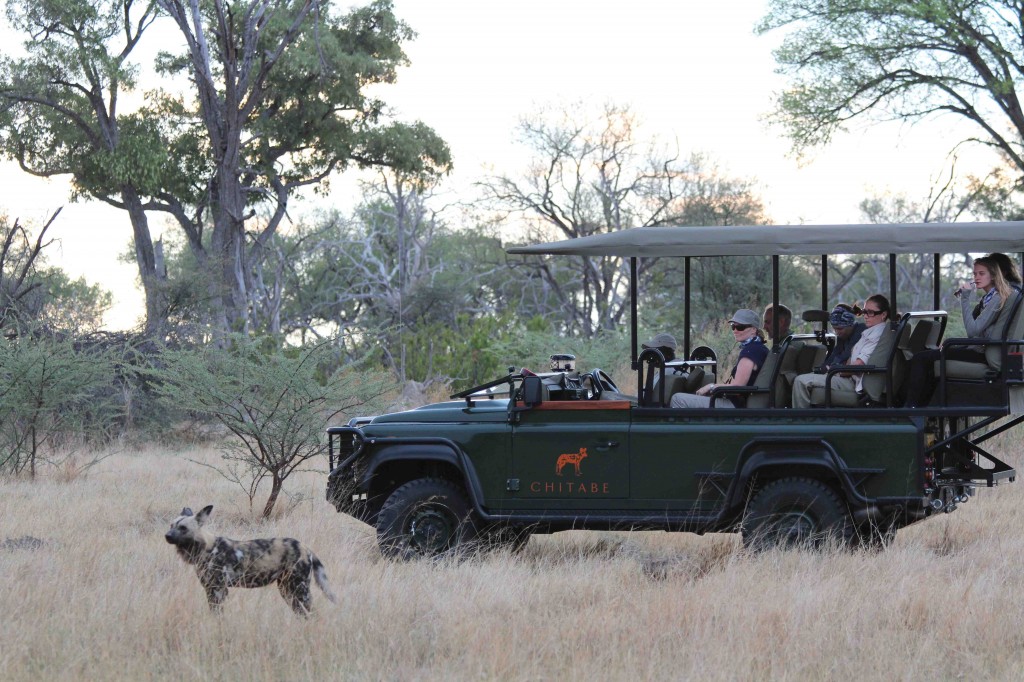
Up close and personal with an African wild dog at Chitabe – the most amazing area I’ve been to for experiences with predators who basically ignore vehicles
Last chance to grab discounted Okavango safari spots!
Imagine that you’re sitting back with a nice sundowner, with a bowl of nibbles within reach, looking out over the magnificent wetlands of the Okavango Delta at sunset, knowing that a sumptuous dinner and a luxury room awaits you on your return to camp…. Well if you’ve ever wanted to do it, here’s your chance to do it with me in a couple of months time! It’s just over two months til I head to the Okavango Delta, Botswana with a group of Aussies and Singaporeans, and I’m starting to get excited. Most people travel to the Okavango in the peak dry season (June-October) but what many don’t know is that the green season is equally awesome. Crashing thunderstorms like only Africa can provide, baby animals being born and green grass rather than brown, are just a few of the season’s draw cards. Of course, it’s also significantly less expensive to travel then.
My favourite safari destinations in Africa
Africa’s a big place. Actually, really big. You can fit all of China, India and much of Europe into it’s vast landscape. So when you’re planning to go on safari, where do you start? And once you’ve been once, and you’ve got the Africa bug, where do you go next?
So what’s your favourite safari destination? It’s a tough question, because they all have their merits. In this blog I’m going to have a crack at sharing my current top 5 safari destinations and let you make up your mind where’s best for you to live out your dream.
1. Okavango Delta, Botswana
It’s not just that the Okavango is literally teeming with wildlife in the most beautiful palm tree lined wetlands you can imagine, it’s that Botswana itself is such a wonderful conservation success story. With strong and stable political leadership, a healthy economy and 45% of the population being employed in tourism, it’s no wonder this land-locked country at the centre of southern Africa is doing so well at conserving its wildlife.
The human population is only about 2 million and most of the country is classified as desert, so you don’t get the human pressures that you get in other more highly populated African nations (violent crime being one of them). You’ll see all sorts of interesting critters in Botswana, including all the big cats, African wild dogs, the sitatunga, a wetland dwelling antelope I have yet to feast my eyes on, and the largest elephant population in the world. Besides that, who wouldn’t want to explore nature in a mokoro?
Suggested Camps: Chitabe (for predators galore), Xigera (for wetlands, mokoros & sitatungas), Vumburra Plains (for pure luxury in my kind of heaven).
2. Zimbabwe
This choice might surprise you. Zimbabwe is where I started my African journey back in 1993 on a safari with my Dad at the age of 15 in the Save Valley Conservancy, and it’s still a special place to me. The Save Valley Conservancy remains one of the best places in Africa to see rare African wild dogs. If you go during June, July, August, you’ve got a very good chance of seeing pups at dens, and that is just the cutest thing ever. If you arrange to visit through me, you can also meet the team running the rhino anti-poaching operation, Bryce and Lara, and the Turgwe Hippo Trust‘s Karen Paolillo, who has been studying the area’s hippos for decades.
I also love Hwange National Park. It feels like old Africa to me, and the wildlife there, especially in the dry season (June-Oct), is spectacular. I’ve had lions walk right beside the open vehicle in Hwange, and elephants in their hundreds lining up at waterholes. The thing about Zimbabwe is that many people aren’t traveling there because of the political instability brought about by the current regime. But I’ve been traveling there with my family in the last five years without any troubles, and the people are as friendly and welcoming as ever. And of course, on the border of Zimbabwe and Zambia is the famous Victoria Falls, which you have to see at least once in your life to have your breath literally taken out of you.
Suggested Camps: Sango (Save Valley Conservancy), Little Makololo (Hwange National Park), the River Club (at Victoria Falls, on the Zambian side near Livingstone)
3. Kenya
I only recently ventured into East Africa, having spent the last couple of decades exploring what southern Africa has to offer, and man, was I blown away by Kenya! They’ve been doing safaris in style there for a long time, and it shows in the quality of the experiences they can offer. One very good reason to go to Kenya is that it has the famous great wildebeest migration in the Masai Mara. You have to time this carefully to make sure you’re in the right place at the right time. I am taking a group of up to 12 to Kenya in July next year (safari details here) and there are still spots available for now, but please don’t wait to register your interest as my other two trips to Namibia and Botswana sold out in record time!).
When I got off the plane at Ol Donyo in the Chyulu Hills, nestled between Amboseli and Tsavo National Parks, I looked across the vast grass plains and up to the gobsmacking sight of Mount Kilimanjaro, and I was speechless. The key with traveling in Kenya is to avoid the crowds of minibuses and go with a good operator that offers you exclusivity with the wildlife. And as always, I suggest staying at lodges that operate in partnerships with local communities and conservation organisations, so you know your tourism dollars are helping make a difference on the ground. Kenya is also the home of Daphne Sheldrick’s famous elephant orphanage, a truly special experience that has brought many tears to the eyes of those who visit.
Suggested lodges: Naibosho (Masai Mara – a luxury, community partnership lodge), Ol Donyo (near Amboseli National Park, operating in partnership with the Big Life Foundation and local Masai community)
4. Namibia
Having lived in Namibia for six years, studying black-faced impalas and later working on human-elephant conflict, I’ve still got a soft spot for this vast desert land. You won’t get a sense of space like this anywhere else in the world. The silence in the Namib desert can be overwhelming when you live in a noisy city, and can actually take a bit of adjusting to! Spotting unique desert creatures like oryxes, springboks and ostriches on the desert plains is one of the best things about being in Namibia, as is seeing the vast congregations of animals at waterholes during the dry season (July-October).
Etosha National Park is famous for its white elephants (coated in white dust from the Etosha salt pan) and is one of the best places in Africa to see black rhinos. I also love the north west of Namibia, the Skeleton Coast and Damaraland, where you get desert adapted lions and elephants eking out an existence alongside traditional ethnic groups like the ovaHimbas. My absolute favourite camp in Namibia? Serra Cafema, for sure. Up on the border with Angola, right at the top of Namibia, on the Kunene River, it’s the most remote camp in Africa and going there is like going to the moon (in a very good way!).
Suggested camps: Ongava (for Etosha & rhinos), Serra Cafema (for having your mind blown by desert solitude), Desert Rhino Camp (Damaraland, for tracking desert rhinos & supporting Save The Rhino Trust)
5. Okay so now I’m up to number five, and of course, this is not easy, as there are lots of other great options for safaris that I’d like to include here, like South Luangwa National Park in Zambia (real wild Africa with tonnes of elephants) and even some I haven’t been to that I really want to see, like Ethiopia, Tanzania and Mozambique, but I think the final choice for this blog, based on what I’ve seen to date, has to be Kruger National Park, South Africa.
There’s really no other national park like Kruger for an awesome ‘big five’ experience. But it’s the private reserves on the edge of the park that you want to stay in. South Africa offers so many luxurious and mid range options for families, couples or groups, that it’s hard to know where to start. You’ll get a lot for less price in South Africa because there’s a lot of competition and very high standards of accommodation. It’s a great starting point for a first safari, especially for families as they specialise in this. At Tinstwalo last year with then 3 year old Solo, we saw the entire big five, including an incredible leopard sighting and mating lions, in 36 hours!
There are excellent malaria-free reserves in South Africa too, guides that specialise in giving kids an amazing learning experience, and you can always add on a few days exploring Capetown and the magnificent mountains and wineries of the region.
Suggested camps: Tintswalo (for luxury, incredible wildlife & families), Grootbos (2 hours from Capetown, for families & marine life)
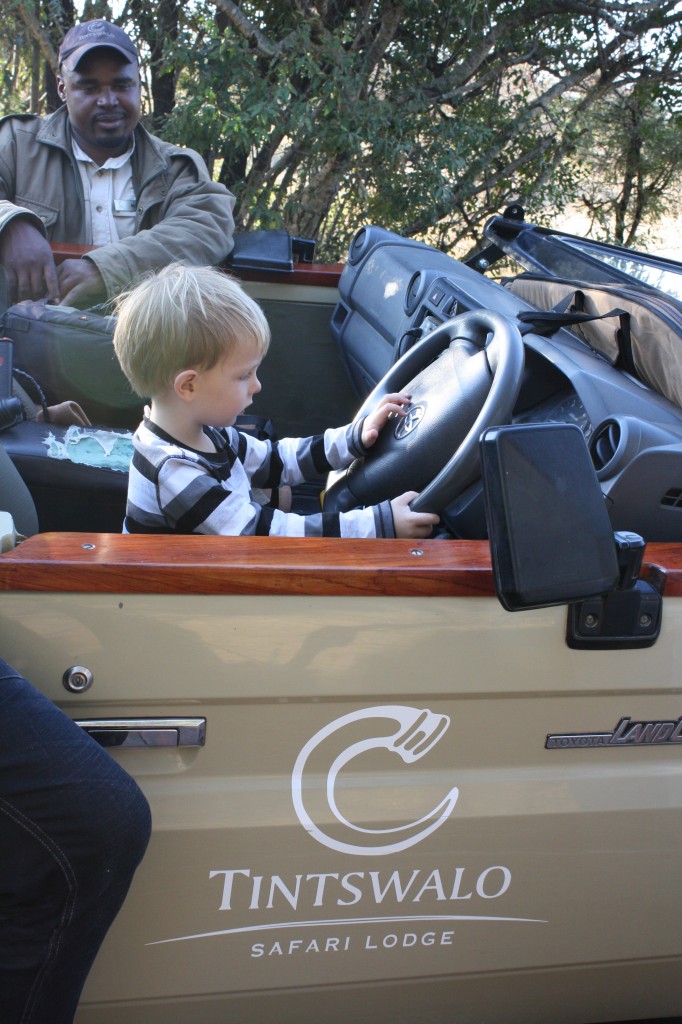
Solo (then aged 3) got to pretend to drive the Land Cruiser while on safari at Tintswalo, South Africa, which was definitely a highlight of the trip for him.

